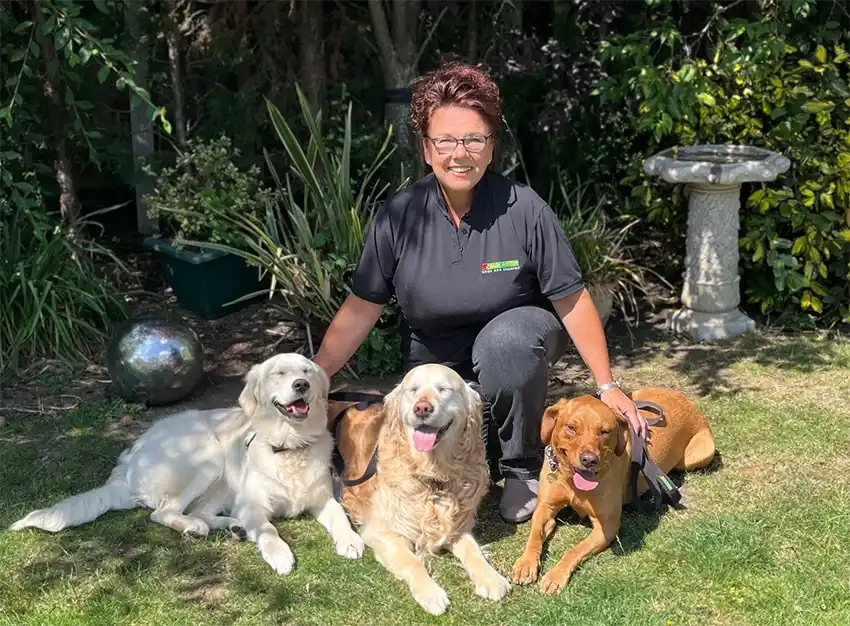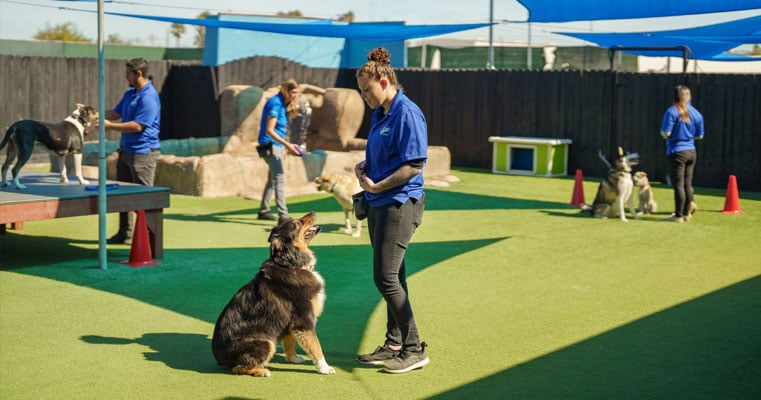The Ultimate Overview to Pet Training: Transform Your Pet dog's Behavior
Reliable pet dog training is necessary for fostering an unified relationship in between family pets and their owners. The ins and outs of canine behavior and the execution of organized training techniques play a vital role in this process. By recognizing the concepts of favorable reinforcement, consistency, and socializing, animal owners can navigate typical challenges that emerge during training. This guide not only intends to furnish you with the required devices to change your pet's habits but likewise invites you to check out just how these foundational ideas can bring about a deeper connection with your animal. What might be the very first step in this transformative trip?
Comprehending Dog Actions
Understanding pet behavior is important for reliable training and an unified partnership in between dogs and their proprietors. A pet's actions is influenced by a mix of genetics, setting, and experiences. Dog training. Recognizing these aspects permits owners to customize their training approaches to meet the specific needs of their family pets
Canines connect primarily with body language, vocalizations, and facial expressions. A wagging tail can show enjoyment or joy, while a put tail might signal fear or submission. Observing these signs enables owners to respond properly, reinforcing positive habits and addressing unfavorable ones successfully.
Additionally, understanding the social framework of pets can supply insights into their behavior. Dogs are pack pets, and they prosper in a structured environment. Developing regular guidelines and clear limits can protect against complication and advertise a feeling of protection.
In addition, acknowledging the natural instincts of dogs, such as need to chase after or dig, is crucial. These instincts can be rerouted via ideal outlets, such as play or exercise. By adequately comprehending these behavioral facets, owners can cultivate a positive training experience, inevitably causing a well-adjusted and obedient canine friend.
Necessary Training Strategies
Efficient canine training counts on a range of important strategies that can considerably improve the learning procedure for both the dog and the owner. One fundamental strategy is positive reinforcement, which entails fulfilling desirable actions with treats, praise, or play. This technique encourages pet dogs to duplicate the behaviors that result in positive results, cultivating a trusting connection in between the family pet and proprietor.
Another secret strategy is uniformity in commands and assumptions. Using the exact same spoken signs and hand signals helps the pet understand what is called for, minimizing confusion and advertising quicker learning. Furthermore, establishing clear limits and guidelines is critical for effective communication.
Socializing is likewise an essential component of training. Subjecting canines to various settings, individuals, and various other pets helps them establish suitable social skills and decreases stress and anxiety in strange situations.
Lastly, patience and timing are vital. Educating sessions ought to be short however regular, ensuring that the dog remains engaged and receptive. By using these important techniques, proprietors can create a favorable and structured training experience that advertises good behavior and strengthens the bond with their canine friends.
Producing a Training Arrange
How can a well-structured training schedule improve a canine's learning experience? A training routine offers uniformity, making sure that canines obtain normal, concentrated instruction. This predictability aids pet dogs understand what is expected of them, enhancing their discovering and enabling far better retention of behaviors and commands.
When creating a training schedule, it is vital to take into consideration the pet's age, breed, and specific character. Youthful puppies may profit from much shorter, a lot more constant sessions, while grown-up pets might thrive with longer, less constant training periods. Including a range of tasks can additionally keep the sessions engaging, preventing boredom and advertising excitement for knowing.
Additionally, organizing training sessions at details times of the day can help solidify a regimen. For example, coupling training with daily walks or playtime can develop a positive organization with learning. It is also crucial to consist of time for support, such as deals with or appreciation, to compensate desired actions without delay.
Last but not least, flexibility is essential. While consistency is vital, being adaptable to the canine's mood or energy level can boost their understanding experience. A well-crafted training timetable inevitably lays the structure for reliable communication and a stronger bond between the canine and owner.
Common Training Obstacles
Regardless of having a well-structured training timetable, pet dog proprietors frequently come across different obstacles during the training process. One common issue is inconsistency in hints and commands. When several relative utilize different terms or tones, a canine might end up being confused, hindering its capacity to discover efficiently.
Another constant difficulty is diversion. Dog training. Canines are normally curious creatures, and external stimulations such as other pets, noises, or individuals can divert their interest during training sessions. This calls for owners to read the article develop a controlled environment or progressively introduce distractions to enhance focus
In addition, varying power levels can influence training results. High-energy pets may battle to settle and concentrate, while a lot more easygoing types might need added motivation to engage. Customizing the training method to fit the specific canine's personality is necessary for success.

Structure a Solid Bond
A strong bond between a pet and its owner is necessary for successful training and overall well-being. Dog training. This partnership cultivates depend on, which is essential for reliable communication during the training process. When a dog feels linked and safe and secure to its proprietor, it is more probable to react favorably to hints and commands
To build this bond, uniformity is key. Establishing a routine that includes normal feeding, workout, and training sessions assists develop a sense of security. Additionally, positive reinforcement methods, such as deals with, praise, and play, reinforce desired behaviors while enhancing the psychological link.
Socialization is an additional important facet of bond-building. Subjecting your pet dog to different atmospheres, individuals, and various other animals helps them really feel more comfy and certain, improving the bond with their proprietor. Taking part in activities with each other, such as strolling, playing fetch, or taking part in obedience training, promotes team effort and common enjoyment.
Verdict

Understanding pet behavior is necessary for efficient training and an unified connection in between canines and their owners.Effective pet dog training counts on a range of essential methods that can considerably enhance the understanding process for both the owner and the canine.Despite having a well-structured training click here for more routine, pet owners commonly encounter numerous difficulties throughout the training procedure.In conclusion, reliable dog training counts on a detailed understanding of canine actions, the application of important methods, and the facility of an organized training routine. By emphasizing positive reinforcement and consistency, pet dog proprietors can dramatically improve their family pets' actions, ultimately guaranteeing an unified partnership and advertising the health of both the dog and its environment.